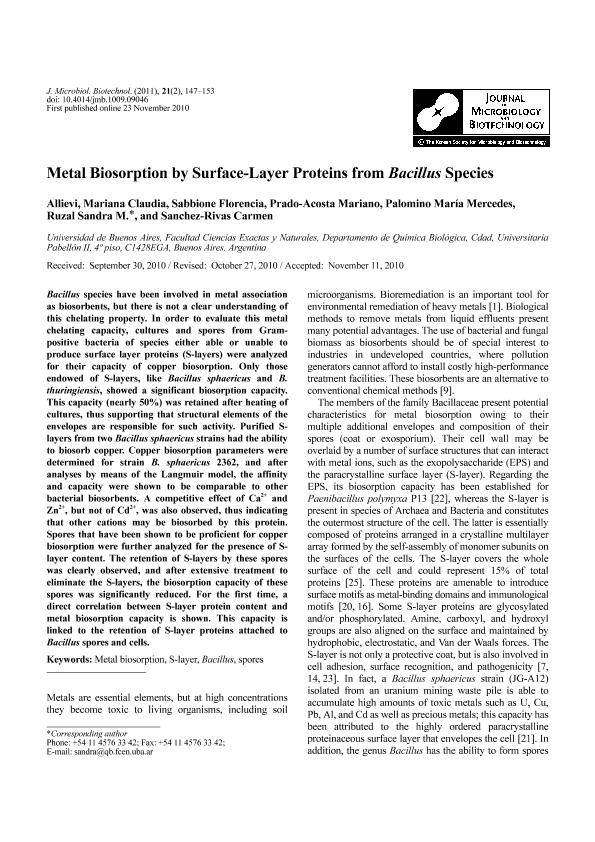Mostrar el registro sencillo del ítem
dc.contributor.author
Allievi, Mariana Caludia

dc.contributor.author
Sabbione, Florencia

dc.contributor.author
Prado Acosta, Mariano

dc.contributor.author
Palomino, Maria Mercedes

dc.contributor.author
Ruzal, Sandra Mónica

dc.contributor.author
Sanchez, Carmen

dc.date.available
2020-01-07T14:38:46Z
dc.date.issued
2011-02
dc.identifier.citation
Allievi, Mariana Caludia; Sabbione, Florencia; Prado Acosta, Mariano; Palomino, Maria Mercedes; Ruzal, Sandra Mónica; et al.; Metal biosorption by surface-layer proteins from Bacillus species; Korean Society Microbiology; Journal of Microbiology and Biotechnology; 21; 2; 2-2011; 147-153
dc.identifier.issn
1017-7825
dc.identifier.uri
http://hdl.handle.net/11336/93753
dc.description.abstract
Bacillus species have been involved in metal association as biosorbents, but there is not a clear understanding of this chelating property. In order to evaluate this metal chelating capacity, cultures and spores from Grampositive bacteria of species either able or unable to produce surface layer proteins (S-layers) were analyzed for their capacity of copper biosorption. Only those endowed of S-layers, like Bacillus sphaericus and B. thuringiensis, showed a significant biosorption capacity. This capacity (nearly 50%) was retained after heating of cultures, thus supporting that structural elements of the envelopes are responsible for such activity. Purified Slayers from two Bacillus sphaericus strains had the ability to biosorb copper. Copper biosorption parameters were determined for strain B. sphaericus 2362, and after analyses by means of the Langmuir model, the affinity and capacity were shown to be comparable to other bacterial biosorbents. A competitive effect of Ca2+ and Zn2+, but not of Cd2+, was also observed, thus indicating that other cations may be biosorbed by this protein. Spores that have been shown to be proficient for copper biosorption were further analyzed for the presence of Slayer content. The retention of S-layers by these spores was clearly observed, and after extensive treatment to eliminate the S-layers, the biosorption capacity of these spores was significantly reduced. For the first time, a direct correlation between S-layer protein content and metal biosorption capacity is shown. This capacity is linked to the retention of S-layer proteins attached to Bacillus spores and cells.
dc.format
application/pdf
dc.language.iso
eng
dc.publisher
Korean Society Microbiology

dc.rights
info:eu-repo/semantics/openAccess
dc.rights.uri
https://creativecommons.org/licenses/by-nc-sa/2.5/ar/
dc.subject
BACILLUS
dc.subject
METAL BIOSORPTION
dc.subject
S-LAYER
dc.subject
SPORES
dc.subject.classification
Otras Biotecnología del Medio Ambiente

dc.subject.classification
Biotecnología del Medio Ambiente

dc.subject.classification
INGENIERÍAS Y TECNOLOGÍAS

dc.title
Metal biosorption by surface-layer proteins from Bacillus species
dc.type
info:eu-repo/semantics/article
dc.type
info:ar-repo/semantics/artículo
dc.type
info:eu-repo/semantics/publishedVersion
dc.date.updated
2019-11-08T15:09:28Z
dc.identifier.eissn
1738-8872
dc.journal.volume
21
dc.journal.number
2
dc.journal.pagination
147-153
dc.journal.pais
Corea del Sur

dc.journal.ciudad
Seul
dc.description.fil
Fil: Allievi, Mariana Caludia. Consejo Nacional de Investigaciones Científicas y Técnicas; Argentina. Universidad de Buenos Aires. Facultad de Ciencias Exactas y Naturales. Departamento de Química Biológica; Argentina
dc.description.fil
Fil: Sabbione, Florencia. Universidad de Buenos Aires. Facultad de Ciencias Exactas y Naturales. Departamento de Química Biológica; Argentina. Consejo Nacional de Investigaciones Científicas y Técnicas; Argentina
dc.description.fil
Fil: Prado Acosta, Mariano. Universidad de Buenos Aires. Facultad de Ciencias Exactas y Naturales. Departamento de Química Biológica; Argentina. Consejo Nacional de Investigaciones Científicas y Técnicas; Argentina
dc.description.fil
Fil: Palomino, Maria Mercedes. Consejo Nacional de Investigaciones Científicas y Técnicas; Argentina. Universidad de Buenos Aires. Facultad de Ciencias Exactas y Naturales. Departamento de Química Biológica; Argentina
dc.description.fil
Fil: Ruzal, Sandra Mónica. Universidad de Buenos Aires. Facultad de Ciencias Exactas y Naturales. Departamento de Química Biológica; Argentina. Consejo Nacional de Investigaciones Científicas y Técnicas; Argentina
dc.description.fil
Fil: Sanchez, Carmen. Consejo Nacional de Investigaciones Científicas y Técnicas; Argentina. Universidad de Buenos Aires. Facultad de Ciencias Exactas y Naturales. Departamento de Química Biológica; Argentina
dc.journal.title
Journal of Microbiology and Biotechnology

dc.relation.alternativeid
info:eu-repo/semantics/altIdentifier/url/http://www.jmb.or.kr/journal/viewJournal.html?year=2011&vol=21&num=2&page=147
dc.relation.alternativeid
info:eu-repo/semantics/altIdentifier/doi/http://dx.doi.org/10.4014/jmb.1009.09046
Archivos asociados
